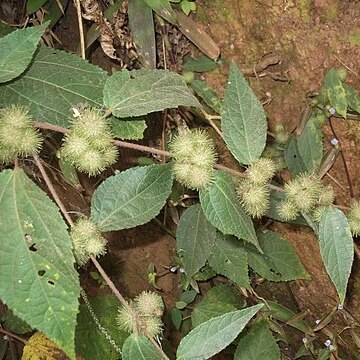Small shrub of about 1.3 m tall; stems often quadrangular, sparingly stellate-pubescent or densely tomentose, hair bases often tubercled. Leaf-blade 50-120 x 30-70 mm, ovate to oblong-lanceolate, acutely acuminate or acute at the apex, rounded to cordate at the base, coarsely serrate, puberulous, pubescent or densely tomentose especially below; petiole up to about 50 mm long, diminishing upwards; stipules up to 8 mm long, subulate. Inflorescence foliose, of small cymes crowded at the nodes; peduncles and pedicels very short, up to 5 mm long but often less; bracts 2.4 mm long, linear to lanceolate-linear, setulose-pubescent. Sepals 7-10 mm long, linear, pubescent or tomentose, subapical horn very short, up to about 1 mm long. Petals yellow, slightly shorter than the sepals, linear to oblanceolate-linear, ciliate at the base. Androgynophore up to 0.75 mm tall, glands opposite base of petals orbicular; annulus densely hirsute above. Stamens 8-10. Ovary globose, echinulate, 3-4-locular. Capsule 15-27 mm in diam. including the prickles; prickles 5-10 mm long, pilose or glabrous, uncinated at the apex.
Herbs woody at base, or subshrubs to 1(-1.5) m tall. Branchlets yellow-brown stellate tomentose, simple hairs also present. Petiole 1-5 cm; leaf blade ovate or narrowly ovate, 3-14 × 1.3-4.5 cm, thickly papery, abaxially densely yellow-brown stellate tomentose, adaxially sparsely stellate, basal veins 3, lateral 2 ascending beyond 1/2 blade, base rounded or subcordate, margin irregularly serrate, apex acuminate or acute. Cymes 1 to several per node; peduncle 5-8 mm. Flower buds pilose. Pedicel 3-5 mm. Bracts lanceolate, ca. 1 mm. Sepals narrowly lanceolate, 6-10(-12) × 1-1.5 mm, hairy, apex cucullate, apical appendage 0.5-1 mm. Petals as long as sepals. Stamens 10(-30). Ovary hairy. Capsule globose, body 3-5 mm in diam., spiny, overall 1.1-1.3 × 1.2-1.4 cm, 4-loculed, dehiscent; spines 6-8 mm, hairy, tip hooked. Fl. summer-autumn.
Small shrub, 0.4-2.1 m high. Leaves ovate to oblong-lanceolate, apex acutely acuminate, base rounded to cordate, margins coarsely serrate. Inflorescences of small cymes crowded at nodes; peduncles and pedicels up to 5 mm long; bracts linear to linear-lanceolate, 2-4 mm long, setulose. Flowers 7-10 mm long, yellow. Sepals linear, subapical horn very short. Petals slightly shorter than sepals, linear to linear-oblanceolate. Androgynophore ± 0.75 mm long, annulus densely hirsute above. Flowering time late summer to Apr. Fruit a capsule, 15-27 mm in diam.; prickles 5-10 mm long, uncinate.
Leaf-lamina 5–12 × 3–7 cm., ovate to oblong-lanceolate, acutely acuminate or acute at the apex, margin coarsely serrate, rounded to cordate at the base, puberulous or pubescent or densely tomentose especially below; petiole up to c. 5 cm. long; stipules up to 0·8 cm. long, subulate.
Inflorescences leafy, of small cymes crowded at the nodes; peduncles of cymes and pedicels very short, up to 5 mm. long, but often less; bracts 2–4 mm. long, linear or lanceolate-linear, setulose-pubescent.
Small shrub c. 1·3 m. tall; stems often quadrangular, sparingly stellate-pubescent or densely tomentose, hair-bases often tubercled.
Fruit 1·5–2·7 cm. in diam. including the aculei; aculei 0·5–1 cm. long, glabrous or pilose, uncinate at the apex.
Petals yellow, slightly shorter than the sepals, linear to oblanceolate-linear, ciliate at the base.
Sepals 7–10 mm. long, linear, pubescent or tomentose; subapical horn very short, c. 1 mm. long.
Androgynophore up to 0·75 mm. tall, glands orbicular; annulus densely hirsute above.
Ovary globose, echinulate, 3–4-locular.
Stamens 8–10.

